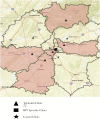Impact of Availability of Telehealth Programs on Documented HIV Viral Suppression: A Cluster-Randomized Program Evaluation in the Veterans Health Administration
- PMID: 31211155
- PMCID: PMC6559276
- DOI: 10.1093/ofid/ofz206
Impact of Availability of Telehealth Programs on Documented HIV Viral Suppression: A Cluster-Randomized Program Evaluation in the Veterans Health Administration
Abstract
Background: Telehealth may improve care for people with HIV who live far from HIV specialty clinics. We conducted a cluster-randomized evaluation to determine the impact of availability of HIV telehealth programs on documented viral suppression in Veterans Administration clinics.
Methods: In 2015-2016, people who previously traveled to HIV specialty clinics were offered telehealth visits in nearby primary care clinics. Patients were cluster-randomized to immediate telehealth availability (n = 925 patients in service areas of 13 primary care clinics offering telehealth) or availability 1 year later (n = 745 patients in 12 clinics). Measures during the evaluation year included telehealth use among patients in areas where telehealth was available and documented HIV viral suppression (viral load performed and <200 copies/mL). Impact of telehealth availability was determined using intention-to-treat (ITT) analyses that compared outcomes for patients in areas where telehealth was available with outcomes for patients where telehealth was not available, regardless of telehealth use. Complier average causal effects (CACEs) compared outcomes for telehealth users with outcomes for control patients with equal propensity to use telehealth, when available.
Results: Overall, 120 (13.0%) patients utilized telehealth when it was available. Availability of telehealth programs led to small improvements in viral suppression in ITT analyses (78.3% vs 74.1%; relative risk [RR], 1.06; 95% confidence interval [CI], 1.01 to 1.11) and large improvements among telehealth users in CACE analyses (91.5% vs 80.0%; RR, 1.14; 95% CI, 1.01 to 1.30).
Conclusions: Availability of telehealth programs improved documented viral suppression. HIV clinics should offer telehealth visits for patients facing travel burdens.
Keywords: HIV; randomized trial; telehealth; veterans.
Figures


References
-
- Schur CL, Berk ML, Dunbar JR, et al. . Where to seek care: an examination of people in rural areas with HIV/AIDS. J Rural Health 2002; 18:337–47. - PubMed
-
- Wilson IB, Landon BE, Ding L, et al. . A national study of the relationship of care site HIV specialization to early adoption of highly active antiretroviral therapy. Med Care 2005; 43:12–20. - PubMed
-
- Hirschhorn LR, Landers S, McInnes DK, et al. . Reported care quality in federal Ryan White HIV/AIDS Program supported networks of HIV/AIDS care. AIDS Care 2009; 21:799–807. - PubMed
-
- Giordano TP, Gifford AL, White AC Jr, et al. . Retention in care: a challenge to survival with HIV infection. Clin Infect Dis 2007; 44:1493–9. - PubMed
LinkOut - more resources
Full Text Sources

